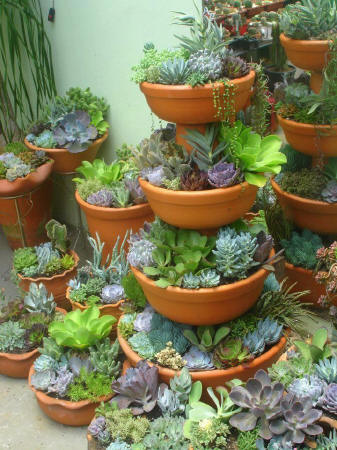Carolyn Black
Adams County Master Gardener
 (4/15)
Succulents are making a colossal debut in the gardening realm. Succulents are popular because they are unique and virtually indestructible. Their varied shapes, colors, and sizes add texture and accent to any landscape. The word “succulent” comes from the Latin word sucus, meaning juice or sap. There are over 10,000 different succulent plants, including cacti. Many are
native to South America, Madagascar, and the Caribbean. They easily adapt to dry conditions by taking advantage of whatever water is available and holding onto it for later use. They are classified as drought resistant and adapt to a dry environment.
(4/15)
Succulents are making a colossal debut in the gardening realm. Succulents are popular because they are unique and virtually indestructible. Their varied shapes, colors, and sizes add texture and accent to any landscape. The word “succulent” comes from the Latin word sucus, meaning juice or sap. There are over 10,000 different succulent plants, including cacti. Many are
native to South America, Madagascar, and the Caribbean. They easily adapt to dry conditions by taking advantage of whatever water is available and holding onto it for later use. They are classified as drought resistant and adapt to a dry environment.
Succulents, depending on the variety, are USDA hardy in zones 3-10. Adams County’s hardiness zone is 6b. Some succulents are able to withstand our winter months and others must be brought inside over the winter. These latter prefer to be placed in a sunny location in the home. Be sure to read the instruction tags and research the variety when purchasing succulents.
Succulents should be potted in a fast-drying mixture that is designed for cacti and succulents. Potting soil can also be amended with perlite to increase aeration and drainage. Most varieties need at least half a day of sunlight.
Overwatering a succulent is the most common cause of plant failure. During the summer, allow the soil to dry out between watering and then water so that the soil is soaked through but not wet. Don’t let the roots sit in soggy or waterlogged soil. Most succulents prefer a slightly acidic soil pH (5.5-6.5) and need very little fertilizer.
Some of the popular succulents are Burro’s Tail (Sedum morganianum), Aloe Vera, and Snake Plant (Sansevieria trifasciata). Sempervivums, commonly called Hens and Chicks and sometimes referred to as Cats and Kittens have made a huge comeback. I remember them in my grandmother’s garden. They can cleverly be grown in containers, strawberry jars, hypertufa, and troughs. They
also tuck nicely into a garden landscape. Hens and Chicks are cold hardy in our area. Sempervivums are similar in appearance to Echeverias, also known as Mexican Hens and Chicks, but the Sempervivum have pointed leaves that are thinner than Echeveria. The leaves of the Echeveria are spherical. Echeverias are rosette-forming tender succulents that come from Mexico and can
grow as large as a dinner plant. They range in color from bright green to blue green to purple and pink. All these plants are zone 9 or 10. They look beautiful in containers and centerpieces, but in this area they must be brought inside for the winter.
Many varieties of Sedum winterize well in our area. Stonecrop is a family of succulent sedum plants that require little care. There are wide selections of colors and hues for the gardener’s enjoyment. The flowers of stonecrop perennials are rich with sweet nectar and attract bees, moths and butterflies. A variety of Stonecrop that is easy to grow in this area is Autumn
Joy. Stonecrop requires little care from the gardener. It has tall, showy blooms that deepen in color as the gardening season progresses. The flower heads form early, bloom in late summer, and add dimension and interest during their dried stage well into winter. Their thick, succulent leaves are able to withstand drought and rainy weather. They prefer full sun and
showcase well in a small mass planting that takes center stage in late summer. The creeping and trailing varieties of Sedum have long been used in rock gardens and as ground covers. Many varieties are extremely cold hardy.
If you want to cultivate your green thumb, succulents are a great starting point. There aren’t many plants better adapted for growing in containers. They do not need frequent watering and their funky shapes and diverse varieties make them truly fun to grow. For those with creative genes, succulents make beautiful living wreaths for a door. They can also be used for autumn
decorations and centerpieces.
Welcome to the fascinating world of succulents. Happy succulent gardening!
Read other articles on house plants
Read other articles by Carolyn Black